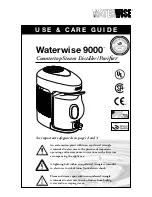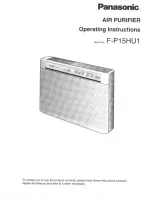
19
M
ANUAL
R
ESET
F
LAME
R
OLLOUT
C
ONTROL
(RS)
Located in the burner compartment at the top of the burner as-
sembly, it senses high temperature that could occur if the heat
exchanger tubes were plugged and the flame was rolling out in-
stead of entering the tubes. It has a manual push-button reset
that cannot be actuated until the limit control has cooled.
The reason for elevated temperatures at the control should be
determined and repaired prior to resetting this manual reset con-
trol.
T
O
AVOID
PROPERTY
DAMAGE
,
PERSONAL
INJURY
OR
DEATH
DUE
TO
FIRE
OR
EXPLOSION
,
A
QUALIFIED
SERVICER
MUST
INVESTIGATE
THE
REASON
FOR
THE
ROLLOUT
PROTECTION
DEVICE
TO
OPEN
BEFORE
MANUALLY
RESETTING
THE
ROLLOUT
PROTECTION
DEVICE
.
WARNING
R
EFRIGERATION
S
YSTEM
C
HECKS
Ensure the hold-down bolts on the compressor are secure and have
not vibrated loose during shipment. Check that vibration grom-
mets have been installed. Visually check all piping and clamps. The
entire refrigeration system has been factory charged and tested,
making it unnecessary to field charge. Factory charges are shown
in Appendix C and on the unit nameplate.
S
TART
-U
P
P
ROCEDURE
AND
C
HECKLIST
Begin with power turned off at all disconnects.
1. Turn thermostat system switch to “Cool,” and fan switch
to “Auto” and turn temperature setting as high as it will
go.
2. Inspect all registers and set them to the normal open
position.
3. Turn on the electrical supply at the disconnect.
4. Turn the fan switch to the “ON” position. The blower
should operate after a 7-second delay.
5. Turn the fan switch to “Auto” position. The blower should
stop after a 65 second delay.
6. Slowly lower the cooling temperature until first stage COOL
(LOW COOL) starts. The blower, both fans, and first stage
compressor should now be operating. Allow the unit to
run 10 minutes, make sure cool air is being supplied by
the unit.
7. Lower the cooling temperature further until second stage
COOL (HIGH COOL) starts. The blower, both fans, and both
compressors should now be operating. Allow the unit to
run 10 minutes, make sure cool air is being supplied by
the unit.
8. Turn the temperature setting to the highest position,
stopping the unit. The indoor blower will continue to run
for 65 seconds.
9. Turn the thermostat system switch to “OFF” and
disconnect all power when servicing the unit.
S
TART
-
UP
P
ROCEDURE
AND
C
HECKLIST
FOR
2 S
PEED
M
ODELS
:
Models with a V in the 11th position of the model number.
For 2 speed models, the indoor blower will operate on low speed
when in “Fan Only” mode or while in first stage “Cooling” mode.
Unit will operate on high speed in “Heating” mode and while in
second stage “Cooling” mode.
The start-up procedure is the same as for “Air Conditioning Start-
up Procedure” with the understanding that in Step 6, the indoor
blower will run at low speed (~1175 motor rpm) and in Step 7, the
indoor blower will operate at high speed (~1775 motor rpm).
NOTE: While in the Cooling Mode, to prevent frost from forming
on the evaporator while the unit is operating in outdoor
temperatures of 65°F or lower, it is recommended that a low
ambient kit (LAKT-**) is used. This is strongly recommended for 2
Speed models due to the lower airflow while in the first stage
cooling. To further protect the compressor from damage during
low ambient conditions, a Freezestat Kit (FSK01) can be added that
turns the compressor off when the evaporator temperature drops
too low.
HIGH VOLTAGE!
D
ISCONNECT
ALL
POWER
BEFORE
SERVICING
OR
INSTALLING
THIS
UNIT
. M
ULTIPLE
POWER
SOURCES
MAY
BE
PRESENT
. F
AILURE
TO
DO
SO
MAY
CAUSE
PROPERTY
DAMAGE
,
PERSONAL
INJURY
OR
DEATH
.
WARNING
NORMAL SEQUENCE OF OPERATION - COOLING
R
EFRIGERATION
S
EQUENCE
C
HECK
With the disconnect switch open, remove the field connected ther-
mostat wire from terminal R on TB1 terminal block. Place a jumper
across terminals R and G, and across R and Y on TB1 terminal block.
Close the disconnect switch. The following operational sequence
should be observed.
1. Current through primary winding of transformer TRANS1
energizes the 24-volt control circuit.
2. To simulate a mechanical call for cooling from the wall
thermostat, place a jumper across terminals R and Y1 of
terminal block TB1.
3. UNIT WITH ECONOMIZER OPTION: The compressor circuit
is interlocked through terminals 3 and 4 of the economizer
module. If the outdoor air enthalpy (temperature and
humidity) is not suitable for cooling, the economizer
terminals will be closed permitting compressor to be
energized.
Summary of Contents for DCG Series
Page 29: ...27 APPENDIX D WIRING DIAGRAMS...
















































